Apple may be developing its thinnest iPhone yet, possibly even breaking the 8-millimeter mark with a significant redesign. Digitimes reported that Apple could use in-cell touch display technology, placing the phone's touch sensors inside the panel rather than above it.
"The advantage of in-cell is that you're streamlining the manufacturing process, so in time you should be able to drive efficiencies and reduce costs," IHS analyst Rhoda Alexander told Wired. "Additionally, by reducing the number of layers, you reduce the size and thickness of the device, making it thinner and lighter."
0.44-mm Thickness Savings
According to Apple Insider, KGI Securities analyst Ming-Chi Kuo agreed with recent rumors that Apple will use in-cell touch panels on its next-generation iPhone. Kuo has issued a report of his own and said the new display design, which would place the touch sensor inside the TFT LCD instead of layering it above, could result in thickness savings of 0.44 millimeters. The thickness savings would be achieved by removing the separate touch sensor and one layer of adhesive.
Apple's current phone, the iPhone 4S, measures 9.3 millimeters in thickness. Kuo, however, believes that Apple aims to break the 8-millimeter mark with its next-generation iPhone. This achievement would allow Apple to stay competitive as rival smartphone makers boast thin designs.
Moreover, according to Kuo's calculations, a thinner battery and the rumored switch from glass to a liquid metal back could further reduce thickness by another 0.96 millimeters. Based on these calculations, Kuo predicts that the next-generation iPhone will measure 7.90 millimeters in depth.
Fewer Layers
Currently, Apple makes the iPhone's "on cell" display in several layers. The back light is at the very bottom, the LCD section is layered directly above it, and a layer of glass comes above. The capacitive touch layer comes on top of the glass, and then topped off by a tough protective layer of Gorilla Glass. The layer of glass between the capacitive touch layer and the Gorilla Glass layer separates the liquid crystal portion of the display from the touch portion. Meanwhile, in-cell display technology combines the LCD and touch sections of the display into a single layer, thus eliminating the middle layer of glass.
According to Kuo, other reasons why Apple would adopt the in-cell technology include "more efficient supply chain management" and improved production yield. The analyst explained that with the current design, bonding occurs at a late stage in the production process, but with in-cell production bonding comes earlier in the process. Due to this fact, Kuo added, in-cell production is quicker and more efficient.
Faster Production Process
The new in-cell production process would require only three semi-finished items at bonding, as opposed to the six required to produce the iPhone 4S. Production procedures could also be reduced from eight to five, and Kuo further indicated that the number of production days required could be reduced from 12 to 16 to just three to five.
Furthermore, the switch to in-cell technology would reportedly involve switching from Optically Clear Adhesive (OCA) to Optically Clear Resin (OCR). OCA bondings cannot be redone, but OCR ones can.
Suppliers
If Apple does indeed switch to in-cell technology for its next iPhone, Apple is expected to source in-cell touch panels from Toshiba Mobile Display, Sharp and LG Display. Kuo expects Apple to launch the next-generation iPhone in the third quarter of 2012, but several recent reports indicated an October release date is more likely. Meanwhile, some still expect the device this summer.
(Reported by Alexandra Burlacu, edited by Dave Clark)
© Copyright 2025 Mobile & Apps, All rights reserved. Do not reproduce without permission.

















